Abstract
1. The involvement of the haloperidol-sensitive, sigma recognition site and the N-methyl-D-aspartic acid (NMDA) receptor in the mediation of the discriminative stimulus properties of (+)-N-allylnormetazocine [+)-NANM, (+)-SKF 10,047), has been investigated in the rat by use of a two-lever, operant drug discrimination paradigm. 2. Six compounds with nanamolar affinity for the sigma recognition site [+/-)-pentazocine, (+)-3-(hydroxyphenyl)-N-propylpiperidine [+)-3-PPP), ditolylguanidine (DTG), haloperidol, (-)-butaclamol and BMY 14802) were investigated for their ability to generalise or antagonise the (+)-NANM discriminative stimulus. Each drug was tested at doses found in an ex vivo radioligand binding assay to displace [3H]-DTG from the central sigma recognition site by more than 40%. 3. While (+/-)-pentazocine (in the presence of naloxone) generalised and (+)-3-PPP partially antagonised the (+)-NANM cue, the other putative sigma ligands were ineffective either as agonists or antagonists at doses clearly occupying the sigma site in vivo. 4. Dose-dependent generalisation to the (+)-NANM cue was seen with the selective non-competitive NMDA receptor antagonist, MK-801, a compound devoid of significant affinity for the sigma recognition site. 5. (+/-)-Pentazocine was found to antagonise seizures induced in the mouse by NMDLA, a model reflecting antagonism of central NMDA receptors, and a strong correlation was found between the rank order of potency of compounds to generalise to the (+)-NANM discriminative stimulus and their potencies as anticonvulsants.(ABSTRACT TRUNCATED AT 250 WORDS)
Full text
PDF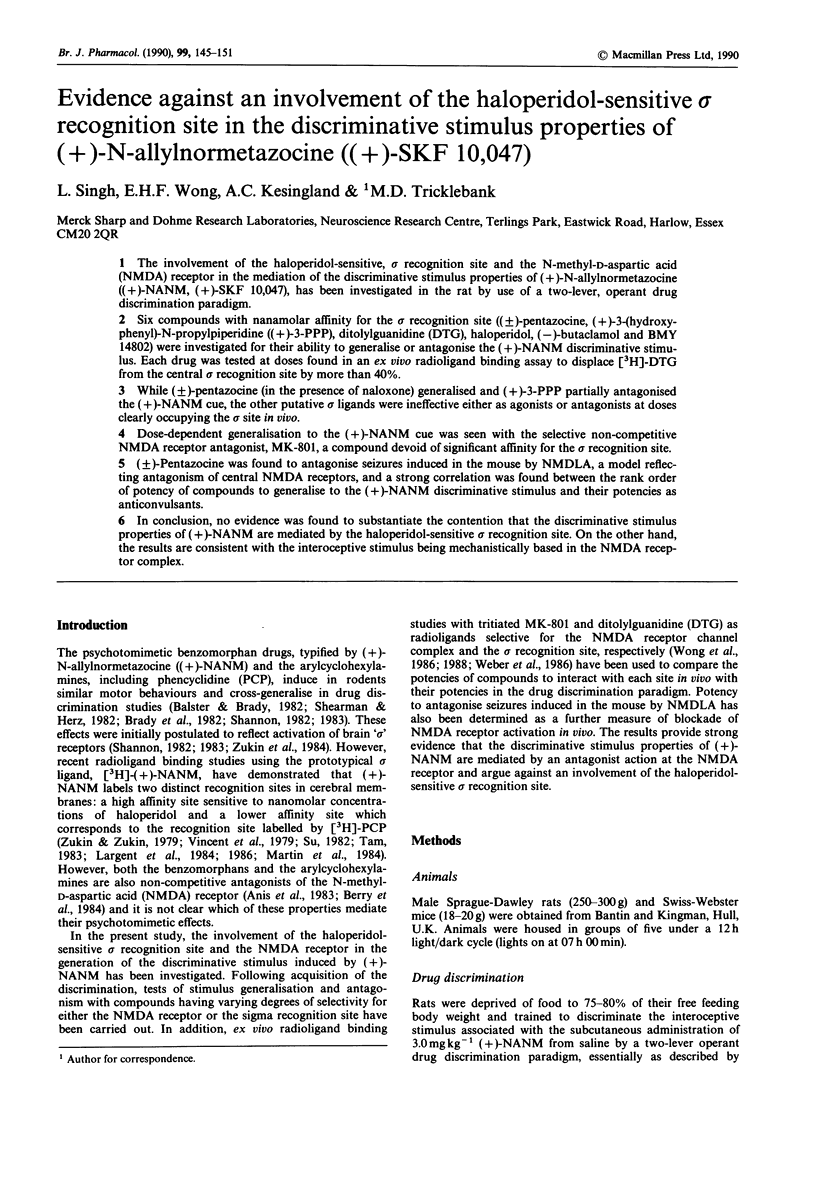
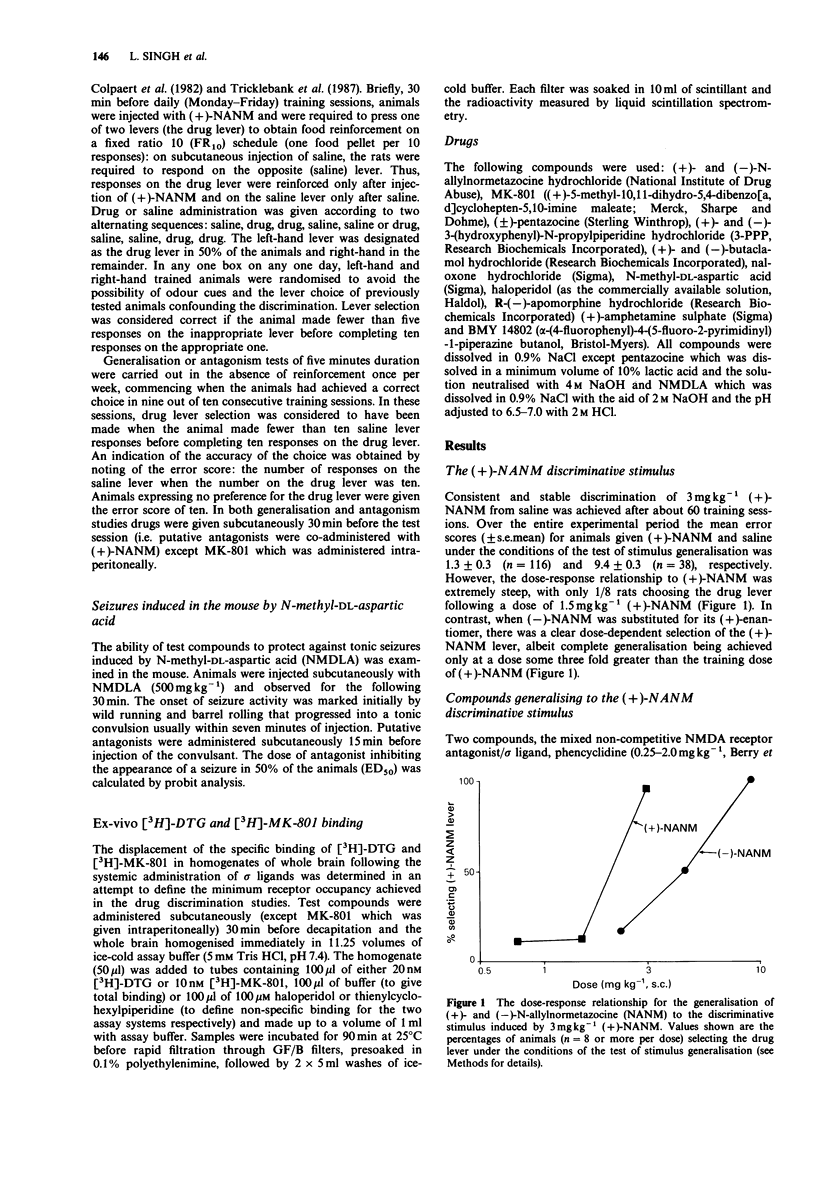
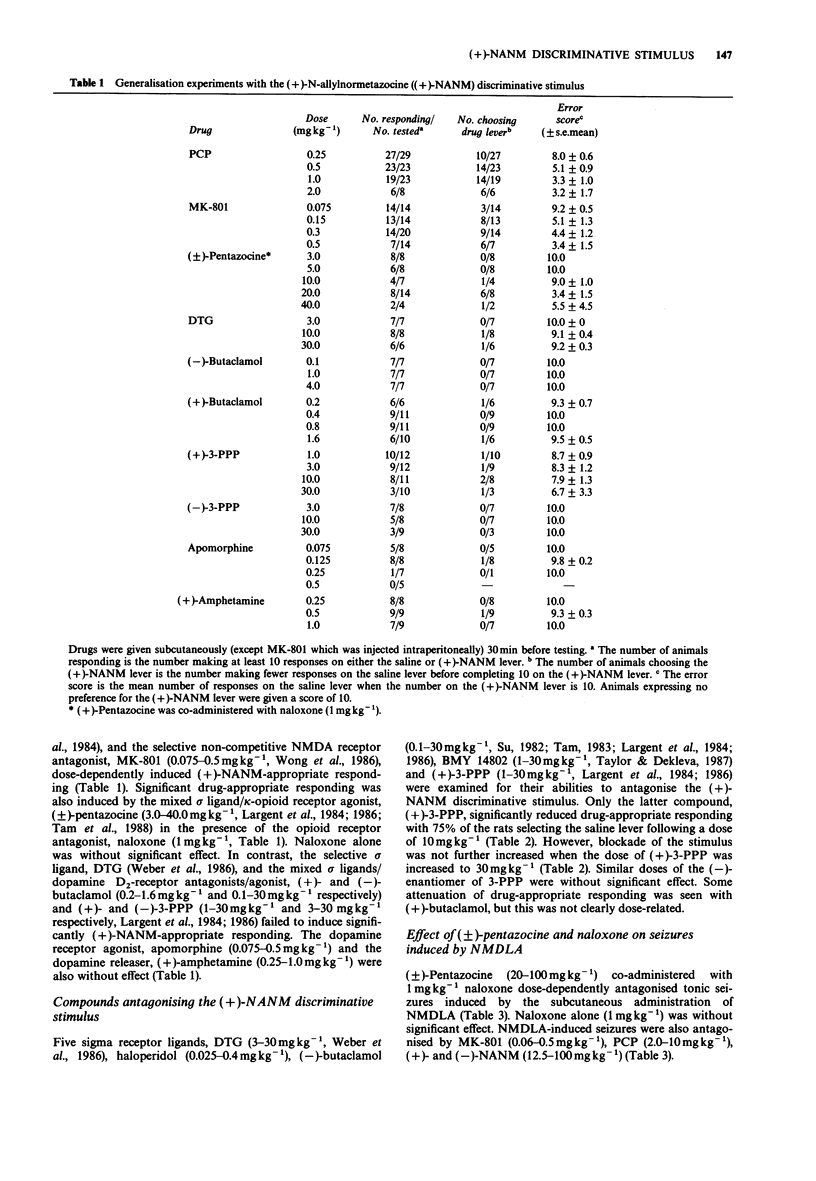
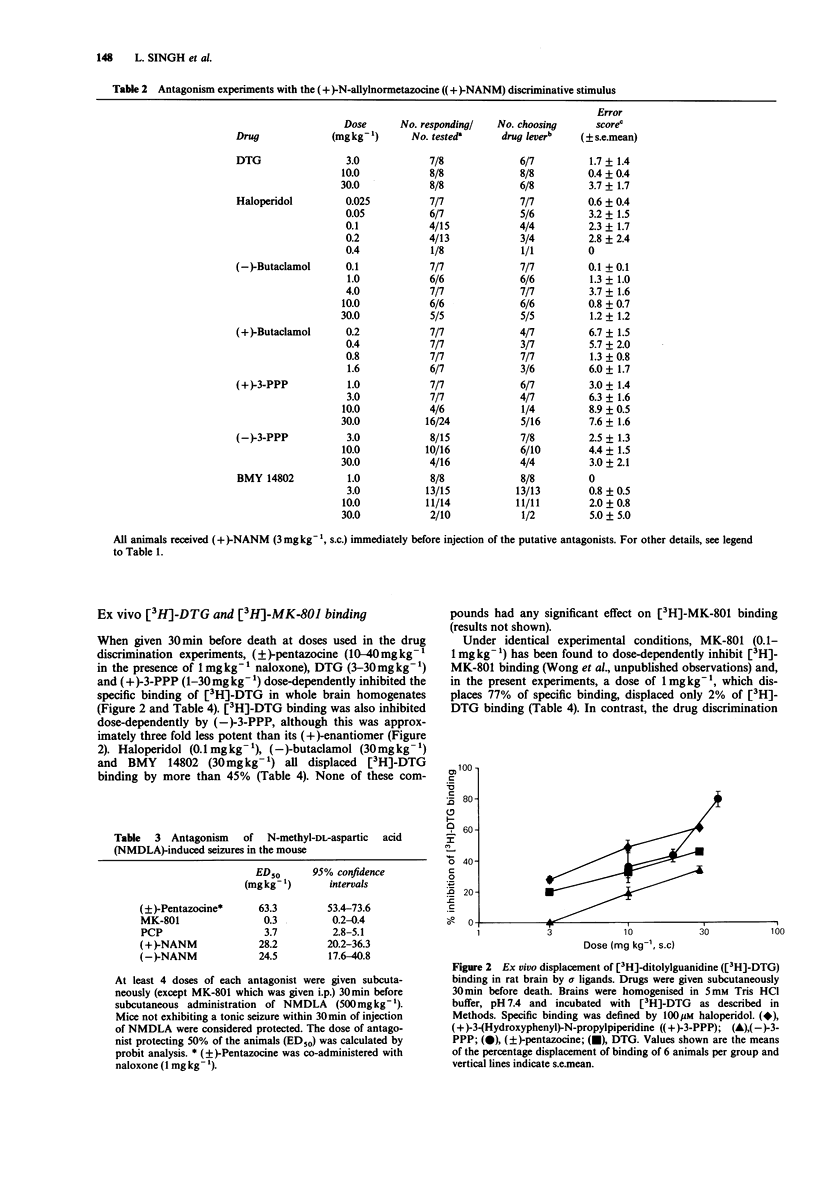
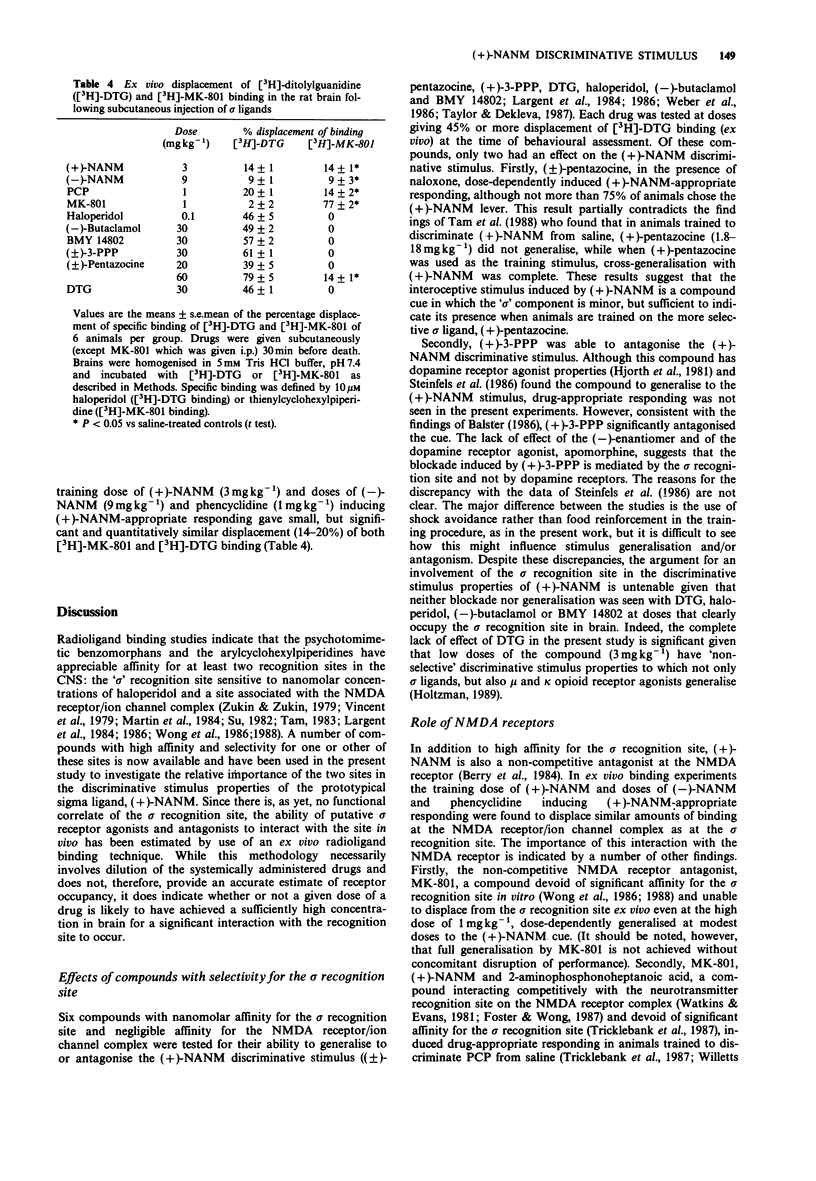
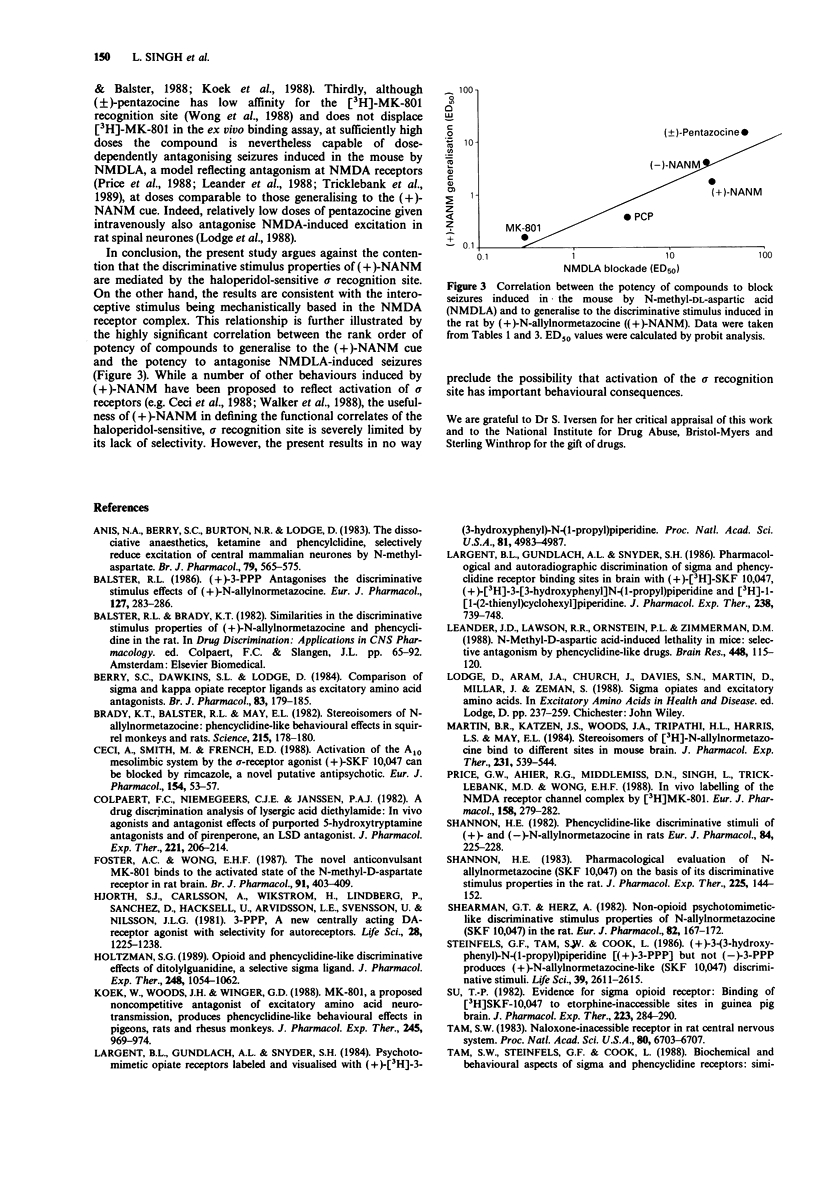
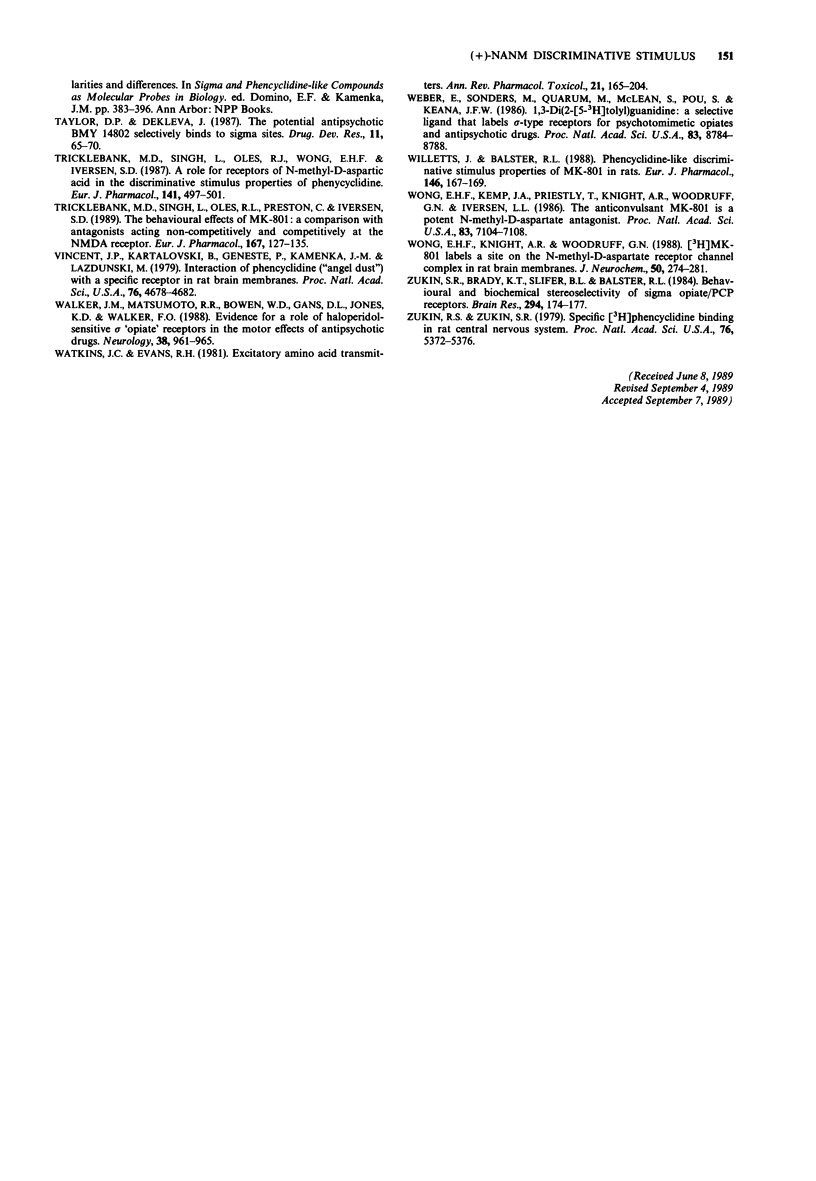
Selected References
These references are in PubMed. This may not be the complete list of references from this article.
- Anis N. A., Berry S. C., Burton N. R., Lodge D. The dissociative anaesthetics, ketamine and phencyclidine, selectively reduce excitation of central mammalian neurones by N-methyl-aspartate. Br J Pharmacol. 1983 Jun;79(2):565–575. doi: 10.1111/j.1476-5381.1983.tb11031.x. [DOI] [PMC free article] [PubMed] [Google Scholar]
- Balster R. L. (+)-3-PPP antagonizes the discriminative stimulus effects of (+)-N-allylnormetazocine. Eur J Pharmacol. 1986 Aug 15;127(3):283–286. doi: 10.1016/0014-2999(86)90377-8. [DOI] [PubMed] [Google Scholar]
- Berry S. C., Dawkins S. L., Lodge D. Comparison of sigma- and kappa-opiate receptor ligands as excitatory amino acid antagonists. Br J Pharmacol. 1984 Sep;83(1):179–185. doi: 10.1111/j.1476-5381.1984.tb10133.x. [DOI] [PMC free article] [PubMed] [Google Scholar]
- Brady K. T., Balster R. L., May E. L. Stereoisomers of N-allylnormetazocine: phencyclidine-like behavioral effects in squirrel monkeys and rats. Science. 1982 Jan 8;215(4529):178–180. doi: 10.1126/science.6274022. [DOI] [PubMed] [Google Scholar]
- Ceci A., Smith M., French E. D. Activation of the A10 mesolimbic system by the sigma-receptor agonist (+)SKF 10,047 can be blocked by rimcazole, a novel putative antipsychotic. Eur J Pharmacol. 1988 Sep 1;154(1):53–57. doi: 10.1016/0014-2999(88)90362-7. [DOI] [PubMed] [Google Scholar]
- Colpaert F. C., Niemegeers C. J., Janssen P. A. A drug discrimination analysis of lysergic acid diethylamide (LSD): in vivo agonist and antagonist effects of purported 5-hydroxytryptamine antagonists and of pirenperone, a LSD-antagonist. J Pharmacol Exp Ther. 1982 Apr;221(1):206–214. [PubMed] [Google Scholar]
- Foster A. C., Wong E. H. The novel anticonvulsant MK-801 binds to the activated state of the N-methyl-D-aspartate receptor in rat brain. Br J Pharmacol. 1987 Jun;91(2):403–409. doi: 10.1111/j.1476-5381.1987.tb10295.x. [DOI] [PMC free article] [PubMed] [Google Scholar]
- Hjorth S., Carlsson A., Wikström H., Lindberg P., Sanchez D., Hacksell U., Arvidsson L. E., Svensson U., Nilsson J. L. 3-PPP, a new centrally acting DA-receptor agonist with selectivity for autoreceptors. Life Sci. 1981 Mar 16;28(11):1225–1238. doi: 10.1016/0024-3205(81)90448-3. [DOI] [PubMed] [Google Scholar]
- Holtzman S. G. Opioid- and phencyclidine-like discriminative effects of ditolylguanidine, a selective sigma ligand. J Pharmacol Exp Ther. 1989 Mar;248(3):1054–1062. [PubMed] [Google Scholar]
- Koek W., Woods J. H., Winger G. D. MK-801, a proposed noncompetitive antagonist of excitatory amino acid neurotransmission, produces phencyclidine-like behavioral effects in pigeons, rats and rhesus monkeys. J Pharmacol Exp Ther. 1988 Jun;245(3):969–974. [PubMed] [Google Scholar]
- Largent B. L., Gundlach A. L., Snyder S. H. Pharmacological and autoradiographic discrimination of sigma and phencyclidine receptor binding sites in brain with (+)-[3H]SKF 10,047, (+)-[3H]-3-[3-hydroxyphenyl]-N-(1-propyl)piperidine and [3H]-1-[1-(2-thienyl)cyclohexyl]piperidine. J Pharmacol Exp Ther. 1986 Aug;238(2):739–748. [PubMed] [Google Scholar]
- Largent B. L., Gundlach A. L., Snyder S. H. Psychotomimetic opiate receptors labeled and visualized with (+)-[3H]3-(3-hydroxyphenyl)-N-(1-propyl)piperidine. Proc Natl Acad Sci U S A. 1984 Aug;81(15):4983–4987. doi: 10.1073/pnas.81.15.4983. [DOI] [PMC free article] [PubMed] [Google Scholar]
- Leander J. D., Lawson R. R., Ornstein P. L., Zimmerman D. M. N-methyl-D-aspartic acid-induced lethality in mice: selective antagonism by phencyclidine-like drugs. Brain Res. 1988 May 10;448(1):115–120. doi: 10.1016/0006-8993(88)91107-9. [DOI] [PubMed] [Google Scholar]
- Martin B. R., Katzen J. S., Woods J. A., Tripathi H. L., Harris L. S., May E. L. Stereoisomers of [3H]-N-allylnormetazocine bind to different sites in mouse brain. J Pharmacol Exp Ther. 1984 Dec;231(3):539–544. [PubMed] [Google Scholar]
- Price G. W., Ahier R. G., Middlemiss D. N., Singh L., Tricklebank M. D., Wong E. H. In vivo labelling of the NMDA receptor channel complex by [3H]MK-801. Eur J Pharmacol. 1988 Dec 13;158(3):279–282. doi: 10.1016/0014-2999(88)90080-5. [DOI] [PubMed] [Google Scholar]
- Shannon H. E. Pharmacological evaluation of N-allynormetazocine (SKF 10,047) on the basis of its discriminative stimulus properties in the rat. J Pharmacol Exp Ther. 1983 Apr;225(1):144–152. [PubMed] [Google Scholar]
- Shannon H. E. Phencyclidine-like discriminative stimuli of (+)- and (-)-N-allylnormetazocine in rats. Eur J Pharmacol. 1982 Oct 22;84(3-4):225–228. doi: 10.1016/0014-2999(82)90207-2. [DOI] [PubMed] [Google Scholar]
- Shearman G. T., Herz A. Non-opioid psychotomimetic-like discriminative stimulus properties of N-allylnormetazocine (SKF 10,047) in the rat. Eur J Pharmacol. 1982 Aug 27;82(3-4):167–172. doi: 10.1016/0014-2999(82)90506-4. [DOI] [PubMed] [Google Scholar]
- Su T. P. Evidence for sigma opioid receptor: binding of [3H]SKF-10047 to etorphine-inaccessible sites in guinea-pig brain. J Pharmacol Exp Ther. 1982 Nov;223(2):284–290. [PubMed] [Google Scholar]
- Tam S. W. Naloxone-inaccessible sigma receptor in rat central nervous system. Proc Natl Acad Sci U S A. 1983 Nov;80(21):6703–6707. doi: 10.1073/pnas.80.21.6703. [DOI] [PMC free article] [PubMed] [Google Scholar]
- Tricklebank M. D., Singh L., Oles R. J., Preston C., Iversen S. D. The behavioural effects of MK-801: a comparison with antagonists acting non-competitively and competitively at the NMDA receptor. Eur J Pharmacol. 1989 Aug 11;167(1):127–135. doi: 10.1016/0014-2999(89)90754-1. [DOI] [PubMed] [Google Scholar]
- Tricklebank M. D., Singh L., Oles R. J., Wong E. H., Iversen S. D. A role for receptors of N-methyl-D-aspartic acid in the discriminative stimulus properties of phencyclidine. Eur J Pharmacol. 1987 Sep 23;141(3):497–501. doi: 10.1016/0014-2999(87)90573-5. [DOI] [PubMed] [Google Scholar]
- Vincent J. P., Kartalovski B., Geneste P., Kamenka J. M., Lazdunski M. Interaction of phencyclidine ("angel dust") with a specific receptor in rat brain membranes. Proc Natl Acad Sci U S A. 1979 Sep;76(9):4678–4682. doi: 10.1073/pnas.76.9.4678. [DOI] [PMC free article] [PubMed] [Google Scholar]
- Walker J. M., Matsumoto R. R., Bowen W. D., Gans D. L., Jones K. D., Walker F. O. Evidence for a role of haloperidol-sensitive sigma-'opiate' receptors in the motor effects of antipsychotic drugs. Neurology. 1988 Jun;38(6):961–965. doi: 10.1212/wnl.38.6.961. [DOI] [PubMed] [Google Scholar]
- Watkins J. C., Evans R. H. Excitatory amino acid transmitters. Annu Rev Pharmacol Toxicol. 1981;21:165–204. doi: 10.1146/annurev.pa.21.040181.001121. [DOI] [PubMed] [Google Scholar]
- Weber E., Sonders M., Quarum M., McLean S., Pou S., Keana J. F. 1,3-Di(2-[5-3H]tolyl)guanidine: a selective ligand that labels sigma-type receptors for psychotomimetic opiates and antipsychotic drugs. Proc Natl Acad Sci U S A. 1986 Nov;83(22):8784–8788. doi: 10.1073/pnas.83.22.8784. [DOI] [PMC free article] [PubMed] [Google Scholar]
- Willetts J., Balster R. L. Phencyclidine-like discriminative stimulus properties of MK-801 in rats. Eur J Pharmacol. 1988 Jan 27;146(1):167–169. doi: 10.1016/0014-2999(88)90498-0. [DOI] [PubMed] [Google Scholar]
- Wong E. H., Kemp J. A., Priestley T., Knight A. R., Woodruff G. N., Iversen L. L. The anticonvulsant MK-801 is a potent N-methyl-D-aspartate antagonist. Proc Natl Acad Sci U S A. 1986 Sep;83(18):7104–7108. doi: 10.1073/pnas.83.18.7104. [DOI] [PMC free article] [PubMed] [Google Scholar]
- Wong E. H., Knight A. R., Woodruff G. N. [3H]MK-801 labels a site on the N-methyl-D-aspartate receptor channel complex in rat brain membranes. J Neurochem. 1988 Jan;50(1):274–281. doi: 10.1111/j.1471-4159.1988.tb13260.x. [DOI] [PubMed] [Google Scholar]
- Zukin S. R., Brady K. T., Slifer B. L., Balster R. L. Behavioral and biochemical stereoselectivity of sigma opiate/PCP receptors. Brain Res. 1984 Feb 27;294(1):174–177. doi: 10.1016/0006-8993(84)91326-x. [DOI] [PubMed] [Google Scholar]
- Zukin S. R., Zukin R. S. Specific [3H]phencyclidine binding in rat central nervous system. Proc Natl Acad Sci U S A. 1979 Oct;76(10):5372–5376. doi: 10.1073/pnas.76.10.5372. [DOI] [PMC free article] [PubMed] [Google Scholar]


